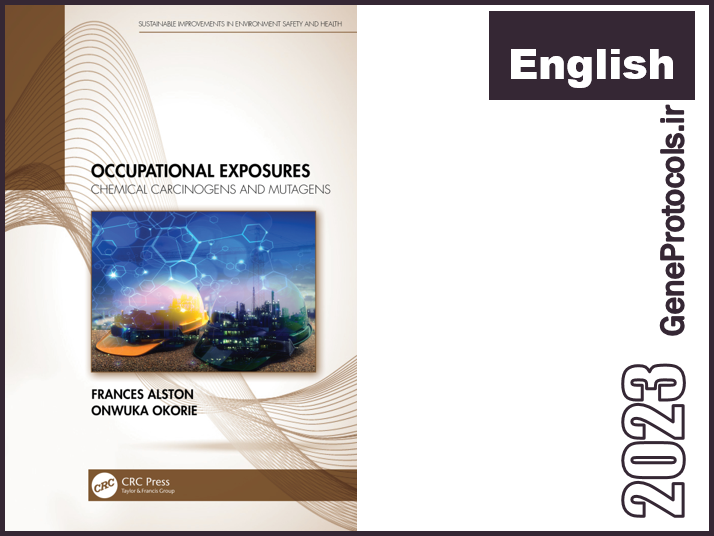-
قابل دانلود از جمعه, ۲ تیر ۱۴۰۲
|
فهرست مطالب: Authors xi1 Polycyclic aromatic hydrocarbons 1 1.1 Introduction 1 1.1.1 Benzene 4 1.2 Exposure pathways 6 1.2.1 Inhalation exposures and impact 6 1.2.2 Dermal exposures and impact 7 1.2.3 Ingestion exposure and impact 7 1.3 Chemical to human interface 7 1.4 Exposure control methods 8 1.4.1 Product elimination and substation 9 1.4.2 Engineering controls 9 1.4.3 Administrative controls 9 1.4.4 Protective equipment and effectiveness 9 1.5 Human biological impact 10 1.5.1 Potential impact to exposed individual 11 1.5.2 Potential impact to offsprings 11 1.6 Treatment of resultant illness 12 References 12 2 Aromatic amines 15 2.1 Introduction 15 2.2 Heterocyclic aromatic amines 18 2.3 Exposure pathways 18 2.3.1 Inhalation exposures and impact 20 2.3.2 Dermal exposures and impact 22 2.3.3 Ingestion exposure and impact 23 2.4 Chemical to human interface 23 vi Contents 2.5 Exposure control methods 25 2.5.1 Product elimination and substation 25 2.5.2 Engineering controls 26 2.5.3 Administrative controls 26 2.5.4 Protective equipment and effectiveness 26 2.6 Human biological impact 27 2.6.1 Potential impact to offsprings 27 2.7 Treatment of resultant illness 28 References 30 3 Nitrosamines 33 3.1 Introduction 33 3.2 Exposure pathways 37 3.2.1 Inhalation exposure and impact 37 3.2.2 Dermal exposure and impact 37 3.2.3 Ingestion exposure and impact 37 3.3 Chemical to human interface 38 3.4 Exposure control methods 38 3.4.1 Product elimination and substitution 39 3.5 Administrative controls 39 3.6 Personal protective equipment 39 3.7 Human biological impact 40 3.7.1 Potential impact on exposed individual 40 3.7.2 Potential impact to off-spring 43 3.8 Treatment of resultant illness 43 References 44 4 Azo dyes 47 4.1 Introduction 47 4.1.1 Azo dye production 53 4.2 Chemical to human interface 54 4.3 Exposure pathways 55 4.3.1 Inhalation exposures and impact 56 4.3.2 Dermal exposures and impact 56 4.3.3 Ingestion exposure and impact 57 4.4 Exposure control methods 57 4.4.1 Product elimination and substitution 58 4.4.2 Engineering controls 58 4.4.3 Administrative controls 58 4.4.4 Protective equipment and effectiveness 58 4.5 Human biological impact 59 4.6 Treatment of resultant illness 59 References 60 5 Carbamates 61 5.1 Introduction 61 5.1.1 Carbamate used as therapeutics 62 5.2 Exposure pathways 62 5.2.1 Inhalation exposures and impact 63 5.2.2 Dermal exposures and impact 64 5.3 Exposure control methods 64 5.3.1 Product elimination and substation 65 5.3.2 Engineering controls 65 5.3.3 Administrative controls 65 5.3.4 Protective equipment and effectiveness 66 5.4 Human biological impact 66 5.4.1 Potential impact on exposed individual 66 5.4.2 Potential impact on off-spring 67 5.5 Treatment of resultant illness 68 Decontamination 68 Respiratory 69 Atropine 69 Oxime 70 Benzodiazepines 70 Disposition 70 5.6 Technical information 73 References 74 6 Halogenated compounds 75 6.1 Introduction 75 6.2 Halogenated hydrocarbons 76 6.3 Halogenated organic compounds 77 6.4 Halogenated solvents 79 6.5 Exposure pathways 82 6.5.1 Inhalation exposures and impact 82 6.5.2 Dermal exposures and impact 82 6.5.3 Ingestion exposure and impact 83 6.6 Chemical to human interface 84 6.7 Exposure control method 84 6.7.1 Product elimination and substation 85 6.7.2 Engineering controls 85 6.7.3 Administrative controls 87 6.7.4 Protective equipment and effectiveness 88 6.8 Human biological impact 88 6.8.1 Potential impact to exposed individual 88 6.8.2 Potential impact on offspring 89 6.9 Treatment of resultant illness 90 References 90 7 Inorganic compounds 93 7.1 Introduction 93 7.2 Exposure pathways 100 7.2.1 Inhalation exposures and impact 102 7.2.2 Dermal exposure impact 102 7.2.3 Ingestion exposure and impact 107 7.3 Chemical to human interface 107 7.4 Exposure control methods 108 7.4.1 Product elimination and substation 108 7.4.2 Engineering controls 109 7.4.3 Administrative controls 111 7.4.4 Protective equipment and effectiveness 111 7.5 Human biological impact 111 7.5.1 Potential impact on exposed individual 114 7.5.2 Potential impact on offspring 115 7.6 Treatment of resultant illness 116 References 116 8 Chemical carcinogens 119 8.1 Introduction 119 8.1.1 Mechanism of cancer formation 120 8.1.2 Common carcinogens 121 8.1.2.1 Asbestos 121 8.1.2.2 Benzene 121 8.1.2.3 Hexavalent chromium 124 8.1.2.4 Formaldehyde 125 8.1.2.5 Silica 125 8.1.2.6 Vinyl chloride 125 8.1.2.7 IARC 126 8.1.2.8 ACGIH 126 8.1.2.9 NTP 126 8.2 Exposure pathways 127 8.2.1 Inhalation exposures and impact 128 8.2.2 Dermal exposures and impact 128 8.2.3 Ingestion exposure and impact 129 8.3 Exposure control methods 129 8.3.1 Engineering controls 129 8.3.2 Administrative controls 130 8.3.3 Protective equipment and effectiveness 130 8.4 Potential impact on exposed individual 131 8.5 Potential impact on offspring 132 8.6 Treatment of resultant illness 132 References 132 9 Mutagens 133 9.1 Introduction 133 9.2 Classification of mutagens 134 9.3 Factors affecting actions of mutagens 135 9.4 Common types of mutagens 135 9.4.1 Base analogues 135 9.4.2 Intercalating agents 136 9.4.3 Metal ions 137 9.4.4 Alkylating agents 138 9.5 Exposure pathways 138 9.5.1 Inhalation exposures and impact 139 9.5.2 Dermal exposures and impact 139 9.6 Exposure control methods 140 9.6.1 Elimination of hazards 140 9.6.2 Engineering controls 140 9.6.3 Administrative controls 141 9.6.4 Personal protective equipment and effectiveness 141 9.6.4.1 Dermal protective PPE 141 9.6.4.2 Respiratory protection 141 9.7 Treatment of resultant illness 142 References 142 10 Chemical agents and occupational-related diseases 143 10.1 Introduction 143 10.2 Occupational diseases from chemical exposures 143 10.3 Prevention of occupational-related diseases resulting from chemicals 144 10.3.1 Occupational cancers 146 10.3.2 Occupational skin diseases 147 10.3.3 Occupational respiratory disease 152 References 154 Appendix A: Exposure and risk assessment strategy 157 Appendix B: Exposure monitoring 163 Appendix C: Personal protective equipment 169 Appendix D: Medical surveillance 181 Index 193 مشخصات فایل |
|
| عنوان (Title): | Occupational Exposures_ Chemical Carcinogens and Mutagens |
| نام فایل (File name): | 1022-www.GeneProtocols.ir-Occupational Exposures_ Chemical Carcinogens and Mutagens-CRC Press (2023).pdf |
| عنوان فارسی (Title in Persian): |
مواجهه شغلی_مواد سرطان زا و جهش زاهای شیمیایی
|
| ایجاد کننده: | Frances Alston, Onwuka Okorie |
| زبان (Language): | انگلیسی English |
| سال انتشار: | 2023 |
| شابک ISBN: | 9781032054506 |
| نوع سند (Doc. type): | کتاب |
| فرمت (File extention): | |
| حجم فایل (File size): | 9.97 مگابایت |
| تعداد صفحات (Book length in pages): | 209 |
پس از پرداخت، دانلود فایل آغاز می شود
درباره درگاه پرداخت نکست پی بیشتر بدانید
تمامی درگاه های پرداخت ژنـ پروتکل توسط شرکت دانش بنیان نکست پی پشتیبانی می شود. نکست پی دارای مجوز رسمی پرداختیاری به شماره 1971/ص/98 ، از شرکت شاپرک و بانک مرکزی جمهوری اسلامی ایران و دارای نماد اعتماد در حوزه (متمرکزکنندگان پرداخت) از مرکز توسعه تجارت الکترونیکی وزارت صنعت معدن و تجارت است.




